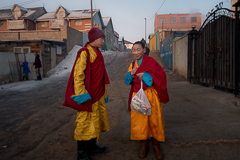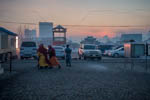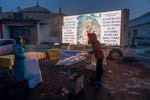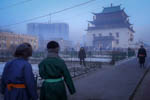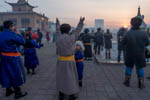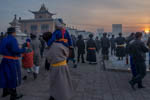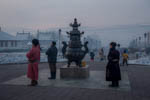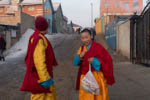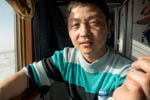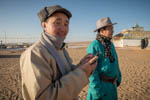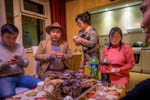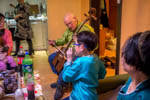White Moon, White Month
Mongolia is among the Asian countries that celebrate the new year using a lunar calendar instead of a solar one—or one devised by ancient Romans—meaning, from a solar or Roman perspective, that its
Tsagaan Sar (white + either moon or month) occurs at a different time every year. If you were a herder in Mongolia any time in the past thousand years or so, White Month, the month that begins when the new moon slips backwards behind the sun as the days start to get longer, would be your sign that marks the end of the coldest part of winter. It's a reason for celebration, occasion for giving thanks to the gracious spirit that kept your
mal from starvation, and more importantly, the time to perform the rituals that will bring you luck in the coming year.
This year
Tsagaan Sar began on February 9, ten days earlier than it did last year, and although this winter has been cold (even by Mongolian standards) the beginning of this
White Month has brought a sense that even we visitors have made it through the worst of the cold weather, that whatever is left can be survived.

Saran Wrapped Ul Boov Display, National Big Store
Weeks in advance, food has been sold from outdoor tents, in large quantities—
aruul, dried curd that may be sweetened and extruded, or formed into blocks;
khonn, sheep, whole carcasses naturally frozen
at attention, stacked into piles like logs;
nerse, wild blueberries,
antz, very close to our cranberries, and
chatsargani, sea buckthorn berries, which I never heard of before coming to Mongolia, sold from frozen heaps in cardboard boxes, by vendors on sidewalks or in crowded squares. At the
National Big Store, traditional clothing has been on sale in the large area on the second floor that contains seasonal items. Sales have progressed from mildly enthusiastic at the beginning of January to feverish the weekend before
White Month started. Finally, there are gifts to buy. Many of them, for people whose home you visit, as well as those who visit your home. Guests bring gifts that may include money. Traditional gifts, and food, are white or off-white, such as dairy products, but these days they very often include chocolate. In chocolate sales per capita, my estimate from the checkout line, Tsagaan Sar must surely put an American Valentine's Day to shame.
There are many other traditions surrounding Tsagaan Sar, though not everyone follows them. Many men (along with small number of women) get up in the dark the first morning, drive as close as they can get to a sacred mountain, and hike the rest of the way to the top in time to see the sun rise, which is said to bring luck for the whole year. I was told by a Mongolian man teaching a
Tsagaan Sar Culture workshop at the US Embasssy to expect to see men up early poking around in the soil, even outside city apartments, though I haven't noticed this behavior. Last year I was one of the men hiking a sacred mountain, and this year Judy and I hiked to Gandantegchinlin Monastery. By the time we got home, everything looked normal, I suspect because with so little soil to scratch around in, many Mongolian men were still sleeping.

Learning Tsagaan Sar
One reason why few women are seen climbing mountains or poking around in the soil in the dark is that they have more pressing things to do. It is customary to have guests for
Tsagaan Sar—many guests, especially at the home of the oldest members of the family. Women start to prepare weeks in advance, making buuz, traditional meat-filled steamed dumplings, by the hundred or often, by the thousand and freezing them—putting them in plastic bags outside. Last minute preparations require making
salat, salads, many of them, enough so that each shift of guests can be presented with a spread that looks like the whole week has been arranged in their honor. Guests are encouraged to eat. And eat. And eat. But eventually practical matter take over. When it is time for guests to leave, they receive a gift, a gesture that foreigners may not pick up on without additional prompting. With so many visitors and so little time, the gift is the signal that more visitors are on the way, another batch of buuz needs to be started, and the salats need to be freshened.
Invisible to outsiders on this national holiday week,
the overriding theme is to get a clean start on the new year. Debts should be paid, disagreements should be settled, and, on
Bituun, the day before Tsagaan Sar, your house should be cleaned. After three years, we have seen quite a variation in the visible details of how each family celebrates this holiday, but here is the best advice I've read for the invisible preparation: The right way to start the new year is with a kind heart and clear conscience.
In addition to our trip to the monastery the first morning, we made a pilgrimage to Sainshand, ten hours by train to the south, to visit friends at their children's first hair cutting ceremony, and to Judy's colleague Dugarmaa's house, where I hope I did not insult Mongolian music too much by playing my moorin khuur. I did it with a good heart, but am feeling a little guilty about it now.
